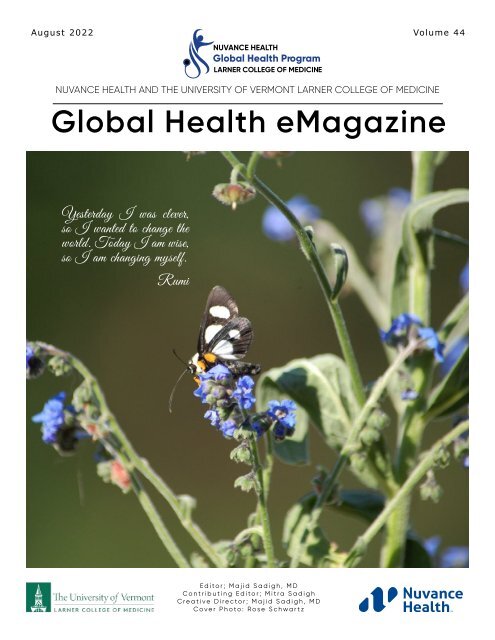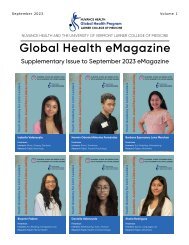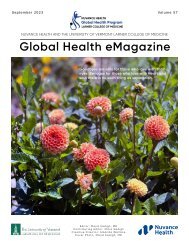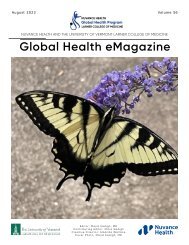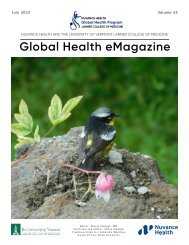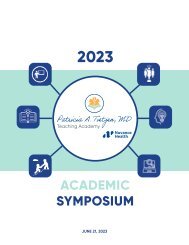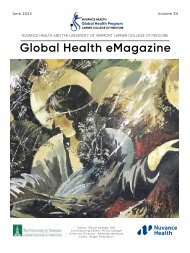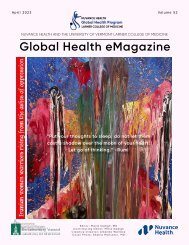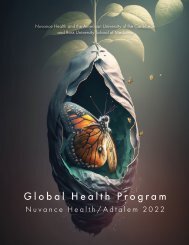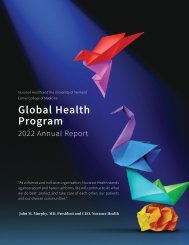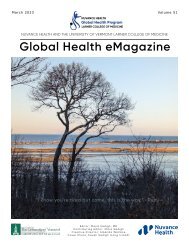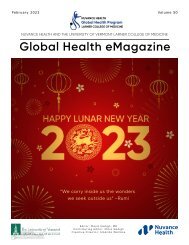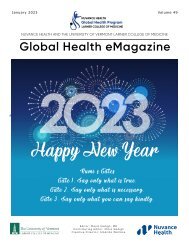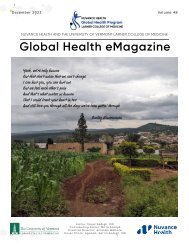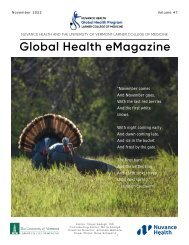eMagazine August 2022
Create successful ePaper yourself
Turn your PDF publications into a flip-book with our unique Google optimized e-Paper software.
<strong>August</strong> <strong>2022</strong> Volume 44<br />
NUVANCE HEALTH<br />
Global Health Program<br />
LARNER COLLEGE OF MEDICINE<br />
NUVANCE HEALTH AND THE UNIVERSITY OF VERMONT LARNER COLLEGE OF MEDICINE<br />
Global Health <strong>eMagazine</strong><br />
Yesterday I was clever,<br />
so I wanted to change the<br />
world. Today I am wise,<br />
so I am changing myself.<br />
Rumi<br />
Editor; Majid Sadigh, MD<br />
Contributing Editor; Mitra Sadigh<br />
Creative Director; Majid Sadigh, MD<br />
Cover Photo: Rose Schwartz
OUR PEOPLE,<br />
OUR MISSION<br />
Global Health<br />
<strong>eMagazine</strong><br />
<strong>August</strong> <strong>2022</strong><br />
Highlights<br />
Clinical Case of the Month<br />
Highlights<br />
Dr. Mariah McNamara, Associate<br />
Director of the Global Health<br />
Program at UVMLCOM and Dr.<br />
Andrea Green, director of global<br />
health in the department of<br />
pediatrics at UVMLCOM had a<br />
successful and rewarding sitevisit<br />
in Uganda. The full report will<br />
be posted in the next <strong>eMagazine</strong><br />
issue.<br />
Reflections<br />
Health Disparities Within Our<br />
Borders<br />
Nursing Division<br />
Art to Remind Us of Who We<br />
Can Be<br />
Our Beautiful Planet<br />
Among the Letters<br />
Congratulations<br />
Dr. Noeline Nakasujja (right) and<br />
Dr. Mariah McNamara (left)<br />
Dr. Andrea Green (right) and<br />
Dr. Sabrina Bakeera-Kitaka (left)<br />
Global Health Team<br />
Calendar<br />
Resources<br />
Dr. Mariah McNamara (second from left) and Dr. Andrea Green (second from right) with the leadership<br />
of ACCESS in Nakaseke, Uganda<br />
2
OUR PEOPLE,<br />
OUR MISSION<br />
Global Health<br />
<strong>eMagazine</strong><br />
<strong>August</strong> <strong>2022</strong><br />
Highlights<br />
Clinical Case of the Month<br />
Reflections<br />
Health Disparities Within Our<br />
Borders<br />
Nursing Division<br />
Art to Remind Us of Who We<br />
Can Be<br />
Our Beautiful Planet<br />
Among the Letters<br />
Congratulations<br />
Global Health Team<br />
Calendar<br />
Resources<br />
Clinical Case<br />
of the Month<br />
Written by Joshua Matsiko<br />
Medical Student at MakCHS<br />
Matsikojoshua091@gmail.com<br />
Skin-Bleaching the Silent<br />
“Pandemic” in the Global South<br />
In the emergency ward of Mulago National<br />
Referral Hospital at around 10 PM while on night<br />
shift, an ambulance brings in a woman who had<br />
been involved in a road traffic accident. She<br />
had multiple lacerated wounds on her face and<br />
right upper limb. Given that all the doctors on<br />
call that night were attending to more severe<br />
emergencies, I was given permission to suture<br />
the lacerations, as they were not very deep,<br />
and I had performed quite a number of suturing<br />
procedures with supervision.<br />
I disinfected the site and applied local anesthesia. On beginning the suturing, I<br />
encountered an unexpected occurrence. Every time I tried to oppose the skin with<br />
average strength, the sutures consistently tore through the skin. My patient’s skin<br />
was softer and thinner than normal. Her skin tone was uneven, with her face very<br />
light-skinned while her lips, fingernails, elbows, knuckles, palms, and hands were<br />
darker. This is a common presentation of patients who use skin bleaching products.<br />
On asking the patient, she endorsed using skin-bleaching lotion. On further<br />
research, I discovered that there was a possibility that this occurrence could be<br />
due to the skin-lightening effects among other possible causes.<br />
With this in mind, I decided to carry<br />
out a short survey on the different<br />
effects of skin-bleaching on<br />
wounds. We observed 108 women<br />
with different kinds of wounds<br />
who were using skin-bleaching<br />
products including but not limited<br />
to bleaching creams, soaps, pills,<br />
injectables, chemical peels, and<br />
laser therapy. We discovered that<br />
these women experienced slower<br />
wound healing, and their wounds<br />
were more prone to infection and<br />
excess bleeding. There was also<br />
3<br />
3<br />
Clinical Case continued on next page >>
OUR PEOPLE,<br />
OUR MISSION<br />
Global Health<br />
<strong>eMagazine</strong><br />
<strong>August</strong> <strong>2022</strong><br />
Highlights<br />
Clinical Case of the Month<br />
Reflections<br />
Health Disparities Within Our<br />
Borders<br />
Nursing Division<br />
Art to Remind Us of Who We<br />
Can Be<br />
Our Beautiful Planet<br />
Among the Letters<br />
Congratulations<br />
Global Health Team<br />
Calendar<br />
Resources<br />
increased wound dehiscence in these patients as well as an increased incidence<br />
of hypertension and diabetes in skin-bleaching populations. On further study, we<br />
found more local and systemic effects of skin bleaching including patchy hyperor<br />
hypopigmentation, skin atrophy, stretch marks, Cushing’s syndrome, adrenal<br />
insufficiency, nephrotic syndrome, neurological disorders, ocular disorders, and<br />
teratogenic effects. The WHO documented that 40% of African women regularly use<br />
bleaching products, and as high as 77% in some countries like Nigeria. In Uganda,<br />
approximately 32% of women regularly use skin-bleaching products.<br />
(https://www.un.org/africarenewal/magazine/april-2019-july-2019/paying-highprice-skin-bleaching#:~:text=Statistics%20compiled%20by%20the%20World,Mali%20<br />
use%20skin%2Dlightening%20products.)<br />
This high prevalence has persisted despite warnings from different entities about the<br />
proven dangers of skin-bleaching chemicals coupled with the lack of proven health<br />
benefits in conditions like hyper-pigmentation and vitiligo that these products claim<br />
to help treat.<br />
On studying the history, I found out that in part, colonization and slavery had a<br />
big role in developing skin-bleaching in Africa and Asia. A paper published by the<br />
American Sociological Society explains, “to justify racial slavery, slave-holding<br />
interests espoused a white supremacist ideology which held that persons of African<br />
descent were innately inferior to whites. Whiteness became identified with all that<br />
is civilized, virtuous and beautiful.” Lighter-skinned slaves received differential<br />
treatment from the darker-skinned ones like working indoors, and were closer<br />
to receiving privileges only given to white people. Unfortunately, this belief has<br />
persisted to date in the Global South where women with lighter skin are not only<br />
considered more attractive—one study showed that 83% of men in Uganda prefer to<br />
have a light-skinned spouse!—but are also more esteemed in society.<br />
Despite much of the Global South being absolutely against skin-bleaching,the tacit<br />
pressures continue to drive the practice. There is also a moderate prevalence of<br />
bleaching in medical students and medical workers of about 19%, based on a short<br />
survey I conducted on 1000 medical students and 100 medical workers.<br />
Skin-bleaching cannot be eliminated through sensitizing the public about its<br />
dangers or banning skin bleaching products, as skin-bleaching is still on the<br />
rise despite approximately 78% of users being aware of its side effects. I believe<br />
the problem is more deep-rooted. Perhaps we should focus on decolonizing the<br />
educational curricula of the Global South and combating the inferiority complex it<br />
perpetuates, and teaching Global South populations to be confident in their color,<br />
which is as beautiful as any other.<br />
At Better Health Uganda, we have been sensitizing children in primary schools to be<br />
confident in who they are while sensitizing the adult generation about bleaching.<br />
4
OUR PEOPLE,<br />
OUR MISSION<br />
Global Health<br />
<strong>eMagazine</strong><br />
<strong>August</strong> <strong>2022</strong><br />
Reflections<br />
Mwanamugimu Nutrition Clinic at<br />
Mulago<br />
Written by William Hsu<br />
University of Vermont Larner College of<br />
Medicine Class of 2025<br />
Highlights<br />
Clinical Case of the Month<br />
Reflections<br />
Health Disparities Within Our<br />
Borders<br />
Nursing Division<br />
Art to Remind Us of Who We<br />
Can Be<br />
Our Beautiful Planet<br />
My second week in Uganda has continued<br />
to be a wonderful, welcoming, and incredibly<br />
informative learning experience. We have<br />
continued to see primarily orthopedic cases,<br />
and were able to visit the lab and imaging<br />
buildings alongside listening in on the HIV<br />
clinic, all of which have been very informative<br />
experiences.<br />
We also visited the Mwanamugimu Nutrition Clinic at Mulago. This clinic, which<br />
has three separate units, treats children who are clinically malnourished. The first<br />
unit, P1, stabilizes the patients and ensures that any existing comorbidities are<br />
addressed. The second unit, P2, helps patients regain the weight and nutrients<br />
they were missing. The final unit, P3, educates parents about how to provide<br />
nutritious meals at an affordable price. This was a great learning experience not<br />
only clinically, but also in terms of medical education as fifth (final) year medical<br />
students rounded with us.<br />
Among the Letters<br />
Congratulations<br />
Global Health Team<br />
Calendar<br />
Resources<br />
William Hsu, center, with classmates from UVMLCOM, at the Mwanamugimu Nutrition Clinic<br />
5<br />
5<br />
Reflections continued on next page >>
OUR PEOPLE,<br />
OUR MISSION<br />
Global Health<br />
<strong>eMagazine</strong><br />
<strong>August</strong> <strong>2022</strong><br />
Highlights<br />
Clinical Case of the Month<br />
However, this was a personally challenging experience. Many very young children<br />
were suffering not only from malnutrition but also malaria, cerebral palsy, or other<br />
comorbidities. This was my first time seeing kwashiorkor and marasmus in children.<br />
I was able to participate in screening incoming children using z-scores from the<br />
World Health Organization, mid-upper arm circumference (MUAC), and presence<br />
of edema. Every child that came in to be screened was severely malnourished<br />
with MUAC scores within the red zone (below 11.5).<br />
While I am of course grateful that these children were receiving much-needed<br />
treatment, it was incredibly challenging to witness the direct health impact<br />
of barriers to food security. Many infants younger than one year were being<br />
fed a primarily carbohydrate diet of mashed Irish potatoes or matoke after<br />
breastfeeding was stopped. This was sometimes due to a lack of resources to<br />
provide the necessary nutrients, and sometimes due to lack of knowledge about<br />
nutrition. The P3 unit’s role in teaching proper nutrition and helping increase food<br />
security is critical to the health of children and communities.<br />
Reflections<br />
Health Disparities Within Our<br />
Borders<br />
Nursing Division<br />
Art to Remind Us of Who We<br />
Can Be<br />
Our Beautiful Planet<br />
Among the Letters<br />
Congratulations<br />
Global Health Team<br />
Calendar<br />
Resources<br />
Bunny (Rose Schwartz)<br />
6
OUR PEOPLE,<br />
OUR MISSION<br />
Global Health<br />
<strong>eMagazine</strong><br />
<strong>August</strong> <strong>2022</strong><br />
Highlights<br />
Clinical Case of the Month<br />
Reflections<br />
Health Disparities Within Our<br />
Borders<br />
Nursing Division<br />
Art to Remind Us of Who We<br />
Can Be<br />
Absorbing My Surroundings<br />
Written by John (Jackson) Burke<br />
University of Vermont Larner College of<br />
Medicine Class of 2025<br />
What a week it has been since we arrived in<br />
Uganda. I think I am finally through the jet lag. I<br />
have a little more energy every day, yet I’m sure<br />
I will burn through it this weekend as we travel<br />
to Jinja to see the source of the Nile and explore<br />
the Mabira forest. My morale is much higher<br />
than it was when I arrived.<br />
As we drove from Entebbe Airport to Kampala, culture shock hit me like a ton of<br />
bricks. Running on one hour of sleep and driving through the dark, I was wondering<br />
what I had gotten myself into. I thought to myself: “I could be home, sleeping in my<br />
own bed with the comforts of my known world around me enjoying my last proper<br />
summer vacation. Instead, I am on the other side of the planet in what feels like a<br />
different planet, exhausted, and homesick not even two days in.” Once we arrived<br />
in Kampala, we got a few hours of sleep before waking up early to check out St.<br />
Stephen’s Hospital. During the walk there, I felt detached. I was overwhelmed by<br />
everything around me and I wondered how I would make it through the month.<br />
Our Beautiful Planet<br />
Among the Letters<br />
Congratulations<br />
Global Health Team<br />
Calendar<br />
Resources<br />
7<br />
7<br />
Reflections continued on next page >>
OUR PEOPLE,<br />
OUR MISSION<br />
Global Health<br />
<strong>eMagazine</strong><br />
<strong>August</strong> <strong>2022</strong><br />
Highlights<br />
Clinical Case of the Month<br />
Reflections<br />
Health Disparities Within Our<br />
Borders<br />
Nursing Division<br />
Art to Remind Us of Who We<br />
Can Be<br />
Things changed when we started traveling to Naggalama. Somehow,<br />
those overwhelming feelings started evaporating as I quietly absorbed my<br />
surroundings through the car window. When we made it to St. Francis Hospital,<br />
the whole hospital team rolled out the welcome wagon for us. On the first night,<br />
the head of the hospital Sister Jane Francis hosted a dinner with a group of the<br />
doctors. Our accommodations are immaculate. I feel spoiled here. The comfort<br />
and kindness of the people have made this adjustment process so much easier,<br />
allowing us to fully jump into our hospital days without issue.<br />
The clinics have been an incredible experience. In four days, I have seen a<br />
mother give birth, a woman with a herniated cervix, a c-section, an 89-year-old<br />
patient with chronic obstructive pulmonary disease (COPD) and pneumonia,<br />
children with sickle cell disease, many patients with malaria, and patients with<br />
HIV, just to name a few things. I am seeing and therefore learning an incredible<br />
amount that is helping me reinforce material I learned during my first year at<br />
school, which has been a godsend in light of my limited clinical experience.<br />
The medical team and my classmates provide strong support in overwhelming<br />
moments. I couldn’t have asked for a better group of people around me.<br />
Two years ago, I was sitting in my apartment in Boston wondering if I would<br />
ever get into medical school. There is no way I could have imagined that in<br />
two years’ time I would be in a global health rotation watching a c-section<br />
in Uganda. Life seems to move in mysterious ways, and I am grateful for this<br />
opportunity.<br />
Our Beautiful Planet<br />
Among the Letters<br />
Congratulations<br />
Global Health Team<br />
Calendar<br />
Resources<br />
(Steve Scholand)<br />
8
OUR PEOPLE,<br />
OUR MISSION<br />
Global Health<br />
<strong>eMagazine</strong><br />
<strong>August</strong> <strong>2022</strong><br />
Highlights<br />
Clinical Case of the Month<br />
Reflections<br />
Health Disparities Within Our<br />
Borders<br />
Nursing Division<br />
Art to Remind Us of Who We<br />
Can Be<br />
Our Beautiful Planet<br />
Among the Letters<br />
Congratulations<br />
Global Health Team<br />
Calendar<br />
Resources<br />
Katanga Community<br />
Written by<br />
Hossein Akbarialiabad MD, MSc<br />
Faculty, Nuvance Health Global Health<br />
Academy<br />
Katanga communites are located in the middle of<br />
Uganda’s capital, Kampala, between Makerere<br />
University and Mulago National Referral<br />
Hospital. The community has a population<br />
of around 5,000, of which two-thirds do not<br />
have a national identity card. A volunteer-run<br />
organization, Katanga 4 Kids educates and<br />
cares for around 50 children ranging from three to seventeen years old who live<br />
on the street in the community. One classroom serves the role of school, stage,<br />
playground, and church. They stay in two dormitories, with three to a bed and<br />
many on the floor.<br />
The Katanga communities are quite<br />
unsafe even during the daytime, even<br />
as a local. In fact, a few days prior to<br />
my arrival, a teenage girl was sexually<br />
assaulted there. As a traveler, safety<br />
is a fundamental issue. There are also<br />
health concerns in this area. Residents<br />
only have access to ten toilets in total,<br />
for which they must pay, meaning<br />
Unhygienic defecation and urination<br />
practices are common, due to a severe<br />
scarcity of toilets—ten in total for 5,000<br />
people—for which residents must pay to<br />
use.<br />
Furthermore, tap water throughout<br />
Uganda must be boiled before use, but<br />
almost 90% of residents in the Katanga<br />
communites cannot afford to purchase<br />
fuel for boiling and sanitizing water,<br />
making cholera a significant concern.<br />
With an average of seven family<br />
members, the average household<br />
income in Katanga is less than 10 USD<br />
per month, forcing everyone regardless<br />
of age to work to feed the family.<br />
“Children have the right to be children all over the world.” This clear notion in highincome<br />
countries is a fantasy here, as even survival is not guaranteed, let alone<br />
mental health, physical safety, and sexual and reproductive health and rights.<br />
9<br />
Reflections continued on next page >><br />
9
OUR PEOPLE,<br />
OUR MISSION<br />
Global Health<br />
<strong>eMagazine</strong><br />
Despite all these challenges, I reveled in watching children play football with<br />
something resembling a ball, screaming joyfully, feeling excitement, and living<br />
their lives. We enjoyed singing multiple songs and dancing with the children of<br />
“Katanga 4 Kids” projects.<br />
<strong>August</strong> <strong>2022</strong><br />
Highlights<br />
Clinical Case of the Month<br />
Reflections<br />
Health Disparities Within Our<br />
Borders<br />
Nursing Division<br />
Art to Remind Us of Who We<br />
Can Be<br />
Our Beautiful Planet<br />
Among the Letters<br />
Congratulations<br />
Global Health Team<br />
Calendar<br />
Resources<br />
Photos from Katanga Community (Majid Sadigh)<br />
10
OUR PEOPLE,<br />
OUR MISSION<br />
Global Health<br />
<strong>eMagazine</strong><br />
<strong>August</strong> <strong>2022</strong><br />
Health Disparities<br />
Within Our Borders<br />
Editor: Ritesh Vidhun<br />
Undergraduate junior at Tufts University<br />
studying public health and economics on the<br />
pre-medical track<br />
Written by Ritesh Vidhun<br />
11<br />
Highlights<br />
Clinical Case of the Month<br />
Reflections<br />
Health Disparities Within Our<br />
Borders<br />
Nursing Division<br />
Art to Remind Us of Who We<br />
Can Be<br />
Our Beautiful Planet<br />
Among the Letters<br />
Congratulations<br />
Global Health Team<br />
Calendar<br />
Resources<br />
Skip a Meal for Your Meds? The<br />
Increasingly Detrimental Situation<br />
of Pharmaceutical Drug Costs in the<br />
United States<br />
Part 1/2<br />
In any society, effective medical care and services are vital for growth and success.<br />
Optimal health is an important aspect of life, and a comprehensive healthcare<br />
system that truly values patient care will help create a more effective population.<br />
One area that plays a critical role in the healthcare system of the United States<br />
is prescription drugs. Medicine and drugs have advanced significantly over the<br />
past century, leading to life-saving cures and improvements in the quality of life.<br />
Consequently, pharmaceutical drug companies play an increasingly significant<br />
role in, not only the American healthcare system, but American society.<br />
Even though the United States<br />
has some of the brightest minds<br />
in biomedical research and drugs<br />
are becoming ever so effective, the<br />
costs for these vital medications<br />
have skyrocketed over recent<br />
years. This has made necessary<br />
prescription drugs unaffordable for<br />
many families across the country.<br />
A 2019 Kaiser Family Foundation<br />
(KFF) Health Tracking Poll recently<br />
found that nearly 8 out of 10<br />
Americans believe that the high<br />
costs of prescription drugs are<br />
unreasonable (Lopes 2019). In such<br />
a scientifically advanced nation like<br />
the United States, why must people<br />
sacrifice so much to obtain basic medications? This is an ever-growing problem<br />
that has recently gained the attention of news outlets and lawmakers across the<br />
nation, as many Americans are starting to realize its detrimental effects. As high<br />
prices of medications start to become the norm, many are turning to Washington<br />
to focus on making pharmaceutical drugs affordable for all Americans. This issue<br />
has generated various proposals from politicians on both sides of the aisle, with<br />
11<br />
Health Disparities continued on next page >>
OUR PEOPLE,<br />
OUR MISSION<br />
Global Health<br />
<strong>eMagazine</strong><br />
<strong>August</strong> <strong>2022</strong><br />
Highlights<br />
Clinical Case of the Month<br />
Reflections<br />
Health Disparities Within Our<br />
Borders<br />
Nursing Division<br />
Art to Remind Us of Who We<br />
Can Be<br />
Our Beautiful Planet<br />
Among the Letters<br />
Congratulations<br />
Global Health Team<br />
Calendar<br />
Resources<br />
varying degrees of support. It is critical to first understand the ways and reasons for<br />
which the pharmaceutical industry has changed, what has truly led to increased<br />
costs, and the effects this has had on the American population.<br />
Firstly, drugs and medications have been constantly evolving, particularly over the<br />
last two decades. New developments in research coupled with increased funding<br />
has led to a higher production of medications for serious illnesses. Advanced<br />
technology has led the pharmaceutical industry “to adapt innovative platforms<br />
to expedite formulation development for special disease classes, scaling up the<br />
synthesis for manufacturing molecules sensitive to temperature and pressure under<br />
cryogenic conditions” (Ali et al. 2018). This focus on furthering research methods and<br />
equipment has led to increased efficiency and success in this field. Additionally,<br />
there have been notable changes in the regulation of the pharmaceutical industry.<br />
In the U.S., the Food and Drug Administration (FDA) is currently working together<br />
with the United States Pharmacopeia as well as other organizations to develop<br />
new guidance as more complex molecules are discovered and new technologies<br />
are being implemented to expedite the development of new drugs.<br />
There are several new<br />
technologies, including gene<br />
therapy, stem cell research,<br />
and nanomedicine, which<br />
have all been beneficial in<br />
helping to drive improved<br />
economics, flexibility and<br />
quality while benefiting<br />
patients both directly and<br />
indirectly. Girish Malhotra<br />
of EPCOT International<br />
explains how there have<br />
been major improvements in new classes of drugs that treat HIV/AIDS to diabetes,<br />
however, “their affordability for the masses due to high prices is becoming<br />
increasingly limited” (qtd. in Ali et al. 2018). This explains a crucial aspect of<br />
these new developments: although there have been tremendous improvements<br />
in pharmaceutical drugs throughout past decades, they have not yet become<br />
accessible for everyone.<br />
The price of research and development, in addition to changing business mindsets<br />
have caused prescription drugs costs to skyrocket. Figures from the Organization<br />
for Economic Cooperation and Development found that Americans spend $1,200<br />
per year on prescription drug costs, the most in the world (Papanicolas 2018).<br />
Furthermore, excluding recent years the increases in drug costs have consistently<br />
exceeded general inflation over the past ten years, rising by nearly 10% each<br />
year from 2010 to 2015 (Hernandez et al. 2019). There are many reasons for this<br />
significant rise in drug prices, ranging from a changing business mindset to the<br />
cost of research and development.<br />
Follow Part 2 in the September issue<br />
12
OUR PEOPLE,<br />
OUR MISSION<br />
Global Health<br />
<strong>eMagazine</strong><br />
<strong>August</strong> <strong>2022</strong><br />
Highlights<br />
Clinical Case of the Month<br />
References<br />
1: Lopes, Lunna, et al. ``KFF Health Tracking Poll – October 2019: Health Care In<br />
The Democratic Debates, Congress, And The Courts.” The Henry J. Kaiser Family<br />
Foundation, 15 Oct.2019, https://www.kff.org/health-reform/poll-finding/kff<br />
healthtracking-poll-october-2019/.<br />
2: Ali, Shaukat, et al. A 20 Year Retrospective: The Pharmaceutical Industry Then and<br />
Now, October 15, Posted:, and 2018. http://www.americanpharmaceuticalreview.<br />
com/Featured-Articles/354573-A-20-Year-Rerospective-The-Pharmaceutical-<br />
Industry-Then-and-Now/.<br />
3: Papanicolas, Irene, et al. “Health Care Spending in the United States and Other<br />
High-Income Countries.” JAMA, vol. 319, no. 10, Mar. 2018, pp. 1024–39. Jamanetwork.<br />
com,doi:10.1001/jama.2018.1150.<br />
Reflections<br />
Health Disparities Within Our<br />
Borders<br />
Nursing Division<br />
Art to Remind Us of Who We<br />
Can Be<br />
Our Beautiful Planet<br />
Among the Letters<br />
Congratulations<br />
Global Health Team<br />
Calendar<br />
Resources<br />
Bath day (Rose Schwartz)<br />
13<br />
13
OUR PEOPLE,<br />
OUR MISSION<br />
Global Health<br />
<strong>eMagazine</strong><br />
<strong>August</strong> <strong>2022</strong><br />
Highlights<br />
Clinical Case of the Month<br />
Reflections<br />
Health Disparities Within Our<br />
Borders<br />
Nursing Division<br />
Art to Remind Us of Who We<br />
Can Be<br />
Our Beautiful Planet<br />
Among the Letters<br />
Congratulations<br />
Global Health Team<br />
Calendar<br />
Resources<br />
Editor:<br />
Nursing Division<br />
Catherine G Winkler, PhD, MPH, APRN-BC<br />
Director of the Nuvance Health Global Health Program Nursing Division<br />
Women’s Health Education<br />
Roe vs. Wade in America<br />
Written by Sarah Cordisco, BSN, RN<br />
Senior Nursing Student at the University of<br />
Vermont<br />
In January of 1973, the U.S Supreme Court<br />
decided on the famous case of Roe V Wade.<br />
This case was filed by Jane Roe, an unmarried<br />
woman living in Texas who wanted to terminate<br />
her pregnancy safely and legally. At the<br />
time, Texas had a law that made it a crime to<br />
perform an abortion unless the woman’s life<br />
was in immediate danger (Planned Parenthood<br />
Federation of America, 2014). When the Court<br />
initially ruled on this case, they recognized the constitutional right to privacy was<br />
“broad enough to encompass a woman’s decision whether or not to terminate her<br />
pregnancy” (Roe V. Wade 1973). This made abortion accessibly and safe for all<br />
people.<br />
To establish this decision, the Court drew on past cases that established the<br />
precedent that the government could not interfere with personal decisions regarding<br />
procreations, marriage, or other parts of family life. In 1965, the Court had ruled on<br />
Griswold v. Connecticut, which was an appeal case of the criminal conviction of the<br />
executive director of the Planned Parenthood League of Connecticut for providing<br />
birth control to married couples. The Court ruled that criminalizing the right to use<br />
birth control violated the privacy rights of married couples. Seven years later, the<br />
justices found that this right also applies to single people in the case Eisenstadt v.<br />
Baird, 1972 (Planned Parenthood Federation of America, 2014).<br />
The Court ruling came at the right time, as by 1965, 17% of all deaths due to<br />
pregnancy and childbirth were the result of illegal abortions (Planned Parenthood<br />
Federation of America, 2014). In the late 1960s, a nationwide effort was underway to<br />
change the law that criminalized the practice. Healthcare providers, women’s rights<br />
activists, clergy members, and the legal community all lobbied state legislatures<br />
and went to court to overturn this statue. Many of these laws date back to the mid-<br />
1800s when legislatures banned abortions despite abortion being allowed prior to<br />
quickening during the colonial times. Prior to the Court ruling on Roe v. Wade states<br />
already began changing their laws. Between 1967 and 1973, four states overturned<br />
their abortion bans, and 13 states enacted limited reforms (Planned Parenthood<br />
Federation of America, 2014).<br />
14
OUR PEOPLE,<br />
OUR MISSION<br />
Global Health<br />
<strong>eMagazine</strong><br />
<strong>August</strong> <strong>2022</strong><br />
Highlights<br />
Clinical Case of the Month<br />
Reflections<br />
Health Disparities Within Our<br />
Borders<br />
Nursing Division<br />
Art to Remind Us of Who We<br />
Can Be<br />
Our Beautiful Planet<br />
Among the Letters<br />
Congratulations<br />
Global Health Team<br />
Calendar<br />
Resources<br />
Roe V Wade gave women the right to make decisions about her pregnancy and<br />
protected it under the constitution. However, the Court also recognized that the<br />
right to privacy is not absolute; therefore, states may ban abortion after the point<br />
of viability, except when it is necessary to protect a women’s life or health. At the<br />
time Roe was decided on, the point of viability was 28 weeks. Today, it is 24 weeks.<br />
Most abortions take place within the first trimester. The CDC estimates that in<br />
2019, 92.7% of all abortions were performed before 13 weeks gestation, 6.2% were<br />
formed at 14-20 weeks, and less than 1% were performed after 21 weeks. The rate<br />
of abortion in 2019, according to the CDC, was 11.4 abortions per 1000 women ages<br />
15-44 years old (CDCs Abortion Surveillance System FAQs | CDC, 2021). Abortion<br />
occuring in later gestation is typically due to either the mother or fetus being at risk<br />
of death during delivery. Only a few fatal fetal abnormalities are detected by 13-<br />
14 weeks, and many are not detected until around 20 weeks (20 Week Ultrasound<br />
(Anatomy Scan), n.d.).<br />
When creating legislation concerning pregnancy and pregnancy-related issues,<br />
women’s health must be at the forefront. Legal abortion is the only way to ensure<br />
safe abortion practices. As we have seen in history, women and girls will still try to<br />
obtain an abortion if they need one, and restricting access leaves many to resort to<br />
unsafe decisions and possibly die. While there have been many restrictions in place<br />
under Roe V Wade, like states banning funding for abortion clinics, or requiring<br />
people to gain consent from their parents, there has always been a choice. For the<br />
first time in 50 years, that choice is no longer a right, but a privilege that depends<br />
on where you live.<br />
On June 24, <strong>2022</strong> the Supreme Court once again voted on Roe V Wade, overturning<br />
the previous decision. This now means that abortion rights are left up to the states<br />
to decide. As of now, 44 states have some form of restrictions on abortions. Seven<br />
states have a complete ban on abortion, three have a ban at six weeks, and two<br />
have a ban at 15 weeks. Only 18 states allow abortion up to the point of viability,<br />
as it was under Roe V Wade (State Bans on Abortion Throughout Pregnancy, <strong>2022</strong>).<br />
The states with total abortion bans do not allow for it in cases of rape or incest,<br />
and deem it only allowed when the women’s life is in immediate danger. This causes<br />
much confusion for healthcare workers, as the laws are not clear in defining what<br />
is considered immediate danger. While abortion is still legalized in several states,<br />
federal and constitutional protections no longer exist for women who seek this<br />
procedure. It is now up to the states.<br />
References<br />
20 Week Ultrasound (Anatomy Scan): What to Expect. (n.d.). Cleveland<br />
Clinic. Retrieved July 26, <strong>2022</strong>, from https://my.clevelandclinic.org/health/<br />
diagnostics/22644-20-week-ultrasound<br />
CDCs Abortion Surveillance System FAQs | CDC. (2021, November 23). https://<br />
www.cdc.gov/reproductivehealth/data_stats/abortion.htm<br />
Planned Parenthood Federation of America. (2014). Roe V Wade: It’s History and<br />
Impact. https://www.plannedparenthood.org/files/3013/9611/5870/Abortion_Roe_<br />
History.pdf<br />
State Bans on Abortion Throughout Pregnancy. (<strong>2022</strong>, July 16). Guttmacher<br />
Institute. https://www.guttmacher.org/state-policy/explore/state-policies-laterabortions<br />
15<br />
15
OUR PEOPLE,<br />
OUR MISSION<br />
Global Health<br />
<strong>eMagazine</strong><br />
<strong>August</strong> <strong>2022</strong><br />
Highlights<br />
Clinical Case of the Month<br />
Reflections<br />
Health Disparities Within Our<br />
Borders<br />
Nursing Division<br />
Art to Remind Us of Who We<br />
Can Be<br />
Our Beautiful Planet<br />
Among the Letters<br />
Congratulations<br />
Global Health Team<br />
Calendar<br />
Resources<br />
An American Nursing Student<br />
Working in a Hospital in<br />
Greece: An Experience of a<br />
Lifetime<br />
Part 1/2<br />
Written by Amanda Towey<br />
Nursing Student at Western Connecticut<br />
State University<br />
Amanda Towey participated in a student<br />
exchange program between Western<br />
Connecticut State University in Danbury,<br />
CT, and International Hellenic University<br />
(Alexander Campus) in Thessaloniki,<br />
Greece. Program funding was provided<br />
by Eramus, Dr. Monica Sousa, Professor<br />
of Nursing from Western Connecticut<br />
State University was the co-faculty lead<br />
on this project.<br />
For the last two-and-a-half months, I have been given the wonderful opportunity<br />
to explore healthcare abroad in Thessaloniki, Greece. As a junior student nurse at<br />
Western Connecticut State University, my education has been centered around<br />
healthcare in the United States. As expected, medical management is different<br />
between the two countries. Greece’s health system aims to provide free access<br />
to healthcare for its residents. I have been privileged to fulfill my externship at<br />
Papageorgiou Hospital, one of Thessaloniki’s newest public hospitals located a<br />
few miles outside of the city center. The hospital staff have welcomed me and<br />
made me feel like I was truly a part of the healthcare they provide. As a foreigner<br />
who speaks only a few short phrases and words in Greek, I have relied heavily upon<br />
observation, gathering as much information as possible through the wonderful<br />
nurses and nursing students that have taken the time to answer my questions.<br />
To begin, I am working on one of two surgical units at Papageorgiou Hospital<br />
called A’XEI. The unit has twelve rooms. The staff consists of doctors, medical<br />
students, nurses, nursing students, aids, and housekeeping. All healthcare settings<br />
have position hierarchies, and in my unit, each member of the staff treats each<br />
other with respect and works together to ensure the best patient care. There is<br />
always adequate staffing, which is not something I am used to in U.S. hospitals. The<br />
patients are admitted before surgery and return to the unit to be cared for after the<br />
procedures are completed. Upon observation, most of the patients receive open<br />
abdominal/gastrointestinal surgeries, with very few performed laparoscopically.<br />
They are taken into the private admitting room where an EKG, blood work, and<br />
a PCR COVID test is done. There are also patients who are admitted onto the<br />
unit for nonsurgical reasons, and that is due to the “on call” days. Every four<br />
days Papageorgiou Hospital is on call to receive all ambulance and emergency<br />
admissions. A’XEI receives overflow patients every eight days because there are two<br />
surgical units at the hospital. The day after the hospital is on call, oftentimes six or<br />
seven patients are assigned to each of the seven larger rooms. It has been noticed<br />
16
OUR PEOPLE,<br />
OUR MISSION<br />
Global Health<br />
<strong>eMagazine</strong><br />
<strong>August</strong> <strong>2022</strong><br />
Highlights<br />
Clinical Case of the Month<br />
Reflections<br />
Health Disparities Within Our<br />
Borders<br />
Nursing Division<br />
Art to Remind Us of Who We<br />
Can Be<br />
that the patient population is younger, and many have been in car accidents.<br />
These patients are not admitted in the same way that the patients scheduled for<br />
surgery are.<br />
The patient population at Papageorgiou Hospital consists of those who are not<br />
able to afford private healthcare. Each patient at the hospital, no matter how long<br />
or extensive their stay, will not have to pay for care. The nurses have explained<br />
that many of the patients seen on the unit and in the hospital are low-income,<br />
elderly, and nomadic people who speak a different Greek dialect. They typically<br />
live outside in tent communities outside the town or city. Further, patients have<br />
more freedom to walk around the hospital, wear their own clothes, and venture<br />
into the waiting area of the unit than they do in the U.S. Walking into the main<br />
lobby, you see staff, families, and patients who have IV poles with medication. The<br />
patients have friendly demeanors even when they are suffering. They make an<br />
effort to learn how to say “good morning” to me in English and ask me where I am<br />
from. Every single day I look forward to my shift on this unit and caring for these<br />
wonderful patients.<br />
Religion is also a large part of the patient population at Papageorgiou Hospital,<br />
and religious practice is highly respected in the unit. A’XEI has religious pictures,<br />
holy books, and a section of the waiting area designated for religious practice.<br />
Patients have pictures under their pillows, and on the walls, surrounding them in<br />
a time of need. I have seen patients reading holy books and praying quite often.<br />
Follow Part 2 in the September issue.<br />
Our Beautiful Planet<br />
Among the Letters<br />
Congratulations<br />
Global Health Team<br />
Calendar<br />
Resources<br />
(Steve Scholand)<br />
17<br />
17
OUR PEOPLE,<br />
OUR MISSION<br />
Global Health<br />
<strong>eMagazine</strong><br />
<strong>August</strong> <strong>2022</strong><br />
Highlights<br />
Clinical Case of the Month<br />
Reflections<br />
Health Disparities Within Our<br />
Borders<br />
Nursing Division<br />
Art to Remind Us of Who We<br />
Can Be<br />
Our Beautiful Planet<br />
Among the Letters<br />
Congratulations<br />
Global Health Team<br />
Calendar<br />
Art To Remind Us<br />
of Who We Can Be<br />
Editor: Majid Sadigh<br />
Contributing Editor: Mitra Sadigh<br />
During times of confusion, tribulation, grief,<br />
uncertainty, and despair, the arts enliven us by<br />
reintegrating the disjointed pieces of ourselves<br />
and replenishing them with clarity and hope. The<br />
arts remind us of our individual and collective<br />
potential to grow, evolve, and transform. They<br />
remind us of what and who we can be and what<br />
we can create. In this new section, we bring you<br />
works of art that have moved and inspired us.<br />
We encourage you to also share works that have<br />
inspired you.<br />
Can an Artists’ Collective in Africa Repair a Colonial Legacy?<br />
Its founders believe that they can use the tools of the Western art<br />
world to help heal the effects of more than a century of plunder.<br />
By Alice Gregory<br />
New Yorker, July 18, <strong>2022</strong><br />
In January, 2020, two young men from Lusanga, a village in the Democratic Republic<br />
of the Congo, flew to New York. Cedart Tamasala had never been to the United<br />
States before; Mathieu Kasiama had, a few years earlier, and, during a visit to the<br />
Metropolitan Museum of Art, he had been scolded by employees for touching a<br />
Resources<br />
Mbuku Kimpala, center, and other collective members, on what used to be a Unilever plantation.<br />
With the proceeds from its art work, the group is slowly buying back land.<br />
Photograph by Léonard Pongo for The New Yorker<br />
18
OUR PEOPLE,<br />
OUR MISSION<br />
Global Health<br />
<strong>eMagazine</strong><br />
<strong>August</strong> <strong>2022</strong><br />
Highlights<br />
Clinical Case of the Month<br />
Reflections<br />
Health Disparities Within Our<br />
Borders<br />
Nursing Division<br />
Art to Remind Us of Who We<br />
Can Be<br />
Our Beautiful Planet<br />
Among the Letters<br />
Congratulations<br />
Global Health Team<br />
Calendar<br />
Resources<br />
Congolese artifact. Together, they went to Times Square and ate Big Macs. Then,<br />
donning winter outerwear, they took the train to New Haven. They had been<br />
invited to address a tropical-forestry conference at Yale, a gathering that brought<br />
together, among others, a Puerto Rican ecologist, a Uruguayan photojournalist, a<br />
Kenyan agriculturist, an Indonesian lawyer, and a Malagasy lemur conservationist.<br />
Tamasala and Kasiama are founding members of the Congolese Plantation Workers<br />
Art League (C.A.T.P.C., as its initials are rendered in French), an artists’ collective<br />
established in 2014 with grand, sometimes surreal-sounding ambitions. Aided by<br />
images projected onto a screen behind him, Tamasala described the group’s work,<br />
which is informed by the legacy of a former palm-oil plantation, once owned by the<br />
giant consumer-goods company Unilever, where many of them lived.<br />
A convoluted schematic appeared on the screen; many arrows were involved.<br />
Tamasala explained that corporations such as Unilever have used the profits<br />
from plantation labor in Africa to fund the cultural enrichment of wealthy Western<br />
populations. A photograph of depleted farmland dissolved into a Pre-Raphaelite<br />
painting of the sort collected by the founder of what would become Unilever.<br />
“Nothing of all this investment goes back to the plantations,” Tamasala said. “It<br />
doesn’t benefit the place where the money comes from.”<br />
Explaining that the Lusangans “had thought about this situation and about how<br />
we might detach ourselves from its grip,” he described the C.A.T.P.C.’s sly, absurdist<br />
approach. The collective, which is made up of some thirty local artists of all ages,<br />
creates figurative sculptures using river clay, which are then scanned in 3-D. The<br />
files are sent to Amsterdam, where they are cast in chocolate, which until recently<br />
most members of the C.A.T.P.C. had never tasted, despite the fact that many of<br />
them harvested the ingredients from which it is made. The finished sculptures—<br />
technically edible, symbolically fraught—are sold in art galleries, mostly in Europe.<br />
With the proceeds from their art work, and with help from a European nonprofit,<br />
the coöperative buys back land—more than two hundred acres so far—and farms it<br />
using ecological methods, to replenish soil devastated by Unilever’s monocultural<br />
farming techniques. The C.A.T.P.C. calls the project a “post-plantation.”<br />
The process, with its dreamlike logic, has transformed life in Lusanga. Plantation<br />
workers there earn twenty or thirty dollars a month; as artists, they make much<br />
more. The collective has brought in more than a hundred thousand dollars since its<br />
creation, and it has had shows in cities including Berlin, Warsaw, Amsterdam, Tokyo,<br />
New York, Copenhagen, and Jeddah.<br />
Tamasala showed a photograph of a man working on a sculpture. “Here you’ll<br />
recognize my colleague Mathieu,” he said, and smiled at Kasiama, who had<br />
remained seated. Kasiama appeared in one of the following images as well—a<br />
portrait accompanying a rave review in the Times of a 2017 C.A.T.P.C. exhibition at<br />
SculptureCenter, in Queens.<br />
Read the Article:<br />
Can an Artists’ Collective in Africa Repair a Colonial Legacy<br />
https://www.newyorker.com/magazine/<strong>2022</strong>/07/25/can-an-artists-collective-inafrica-repair-a-colonial-legacy<br />
19<br />
19
OUR PEOPLE,<br />
OUR MISSION<br />
Global Health<br />
<strong>eMagazine</strong><br />
<strong>August</strong> <strong>2022</strong><br />
Our Beautiful Planet<br />
Editor; Dilyara F. Nurkhametova, MD, PhD<br />
This new column exhibits the beauties of our planet earth and our everyday<br />
destructive actions against it.<br />
Award-winning photographer Mandy Barker shows us a new perspective on the<br />
devastating and far-reaching impact of marine plastic pollution through her art.<br />
Highlights<br />
Clinical Case of the Month<br />
Reflections<br />
Health Disparities Within Our<br />
Borders<br />
Nursing Division<br />
Art to Remind Us of Who We<br />
Can Be<br />
Our Beautiful Planet<br />
Among the Letters<br />
Congratulations<br />
Global Health Team<br />
Calendar<br />
Resources<br />
20
OUR PEOPLE,<br />
OUR MISSION<br />
Global Health<br />
<strong>eMagazine</strong><br />
<strong>August</strong> <strong>2022</strong><br />
Highlights<br />
Clinical Case of the Month<br />
Reflections<br />
Health Disparities Within Our<br />
Borders<br />
Nursing Division<br />
Art to Remind Us of Who We<br />
Can Be<br />
Our Beautiful Planet<br />
Among the Letters<br />
Congratulations<br />
Global Health Team<br />
Calendar<br />
Resources<br />
Watch this six-minute documentary below (WaterBear ):<br />
Trapped by Plastic Planet continued on next page >><br />
21<br />
21
OUR PEOPLE,<br />
OUR MISSION<br />
Global Health<br />
<strong>eMagazine</strong><br />
<strong>August</strong> <strong>2022</strong><br />
Highlights<br />
Clinical Case of the Month<br />
Reflections<br />
Health Disparities Within Our<br />
Borders<br />
Nursing Division<br />
Art to Remind Us of Who We<br />
Can Be<br />
Our Beautiful Planet<br />
Among the Letters<br />
Congratulations<br />
Global Health Team<br />
Calendar<br />
Resources<br />
Listen to Bach, The Earth from “Solaris”<br />
Linking health justice, social justice, and climate justice<br />
Khadj Rouf, Tony Wainwright<br />
The Lancet, The Planetary Health, Volume 4, Issue 4, April 01, 2020<br />
Linking health, social, and climate justice can lead to the transformative activism<br />
that is needed for a better, healthier, and fairer world for everyone. The question<br />
now is, are you willing to help?<br />
Climate emergency is here. In 2019, many catastrophic climate events occurred,<br />
including huge cyclones in Mozambique and The Bahamas, protracted bushfires<br />
in Australia, and widespread flooding in Jakarta, Indonesia. Climate models<br />
predict further unprecedented and extreme weather events due to global heating.<br />
Unfortunately, there is still no unified political consensus regarding how to respond<br />
to the emergency. Individuals’ perceptions have a huge effect on how they respond<br />
to crises. If something is not perceived as an emergency, people do not react<br />
quickly. If people recognise that there is an emergency, then those people act to<br />
prevent further harms, prepare for and mitigate against harm, adapt, and have<br />
emergency drills. This action is part of good safety planning and it saves lives. Yet,<br />
some individuals are skeptical about whether the global climate crisis is happening,<br />
and whether human activity is responsible. Political orientation and ideology might<br />
influence framing of climate change and shared perceptions of the problem. There<br />
is a range of responses to the climate emergency, which are shaped by power,<br />
privilege, and psychology. Psychology shapes how individuals perceive risk and<br />
whether they connect health, social, and environmental justice together as related<br />
issues that affect everyone.<br />
Read the Article<br />
Health Justice, Social Justice, and Climate Justice<br />
22
OUR PEOPLE,<br />
OUR MISSION<br />
Global Health<br />
<strong>eMagazine</strong><br />
<strong>August</strong> <strong>2022</strong><br />
Highlights<br />
Clinical Case of the Month<br />
Reflections<br />
Health Disparities Within Our<br />
Borders<br />
Nursing Division<br />
Art to Remind Us of Who We<br />
Can Be<br />
Our Beautiful Planet<br />
Among the Letters<br />
Congratulations<br />
Among the Letters<br />
We are having a great time with our guests. They have a great sense of humor.<br />
Today, we have all of them since the pair at Naggalama came over for a city<br />
tour ahead of the switch over tomorrow. The road by our residence is finally being<br />
paved. We are therefore hopeful that after the current boost the dust levels<br />
will drop to more manageable levels. We have many monkeys and don’t know<br />
how to get rid of them. The water supply pipes have been cut by the road works.<br />
We are having to truck in supplies. We managed to install a good internet router<br />
but utilization is hampered by high-cost data. The cost of everything has skyrocketed.<br />
Inflation is at an all-time high, partly because of the war in Ukraine. It<br />
is very dry here but not too hot. None of us or the guests are in danger of suffering<br />
heat stroke.<br />
Be blessed<br />
Sam Luboga<br />
I have just wrapped up a very productive meeting with Noeline and some other<br />
colleagues in both public and mental health.<br />
I believe utilizing a rapid needs health assessment in Katwe and Karamoja will<br />
be not only useful but necessary.<br />
I look forward to speaking about this with you and Noeline via Zoom and getting<br />
your input.<br />
Gina de la Chesnaye<br />
Global Health Team<br />
Calendar<br />
Resources<br />
Click here to visit the Nuvance<br />
Health Global Health Program<br />
COVID-19 Resource Center<br />
23<br />
23
OUR PEOPLE,<br />
OUR MISSION<br />
Congratulations<br />
Global Health<br />
<strong>eMagazine</strong><br />
<strong>August</strong> <strong>2022</strong><br />
Highlights<br />
Clinical Case of the Month<br />
Reflections<br />
Health Disparities Within Our<br />
Borders<br />
Nursing Division<br />
Art to Remind Us of Who We<br />
Can Be<br />
Our Beautiful Planet<br />
The Nuvance Health/UVMLCOM Global Health<br />
Program congratulates Dr. Abhay Gaidhane, Dean<br />
of Jawaharlal Nehru Medical College, Datta Meghe<br />
Institute of Medical Sciences (Deemed to be University).<br />
After obtaining primary medical qualification in<br />
1996, Dr. Gaidhane completed his post-graduation<br />
in Preventive and Social Medicine in 2002. Dr. Abhay<br />
Gaidhane was formerly the Dean of Global Health as<br />
well as the Director of School of Epidemiology and<br />
Public Health at the Datta Meghe Institute of Medical<br />
Sciences (DU). He is also the Chair of the Bioethics Unit<br />
at DMIMS, under the International Network of UNESCO<br />
Chair of Bioethics (Haifa).<br />
Dr. Abhay Gaidhane has over 100 publications in peer reviewed journals including,<br />
but not limited to, PLOS, BMC Public Health, Cochrane, Lancet etc. Dr. Abhay is also a<br />
recipient of seven grant awards for research projects from Grand Challenges Canada,<br />
Ministry of Health, and Family Welfare (India), NACO, USAID (USA).<br />
Dr. Abhay Gaidhane has been extremely supportive of the global health partnership<br />
between Nuvance Health/UVMLCOM and DMIMS (DU) from its inception. The Nuvance<br />
Health/UVMLCOM Global Health Program wishes him all the best for his new journey<br />
at DMIMS (DU).<br />
Among the Letters<br />
Congratulations<br />
Global Health Team<br />
Calendar<br />
Resources<br />
Robert Kalyesubula, MD, PhD is the founder<br />
and president of the African Community<br />
Center for Social Sustainability (ACCESS), an<br />
exemplary community-based organization in<br />
Uganda.<br />
Here is the link to the publication<br />
Measuring kidney function in sub-Saharan Africa<br />
Congratulations to Dr. Robert Kalyesubula<br />
for being conferred a PhD from the London<br />
School of Hygiene and Tropical Medicine. We<br />
also congratulate him for his publication in the<br />
Lancet Global Health on measuring kidney<br />
function in sub-Saharan Africa.<br />
24
OUR PEOPLE,<br />
OUR MISSION<br />
Global Health<br />
<strong>eMagazine</strong><br />
<strong>August</strong> <strong>2022</strong><br />
Highlights<br />
Clinical Case of the Month<br />
Reflections<br />
Health Disparities Within Our<br />
Borders<br />
Nursing Division<br />
Art to Remind Us of Who We<br />
Can Be<br />
Our Beautiful Planet<br />
Among the Letters<br />
Congratulations<br />
Global Health Team<br />
Calendar<br />
Resources<br />
July 07, <strong>2022</strong><br />
Global Health Team<br />
Weekly Meetings<br />
During a meeting with Dr. Vincent Setlhare, the point person of the program at<br />
Botswana University, the details of establishing a homestay model in Gaborone<br />
for the global health elective participants from Nuvance Health and UVMLCOM,<br />
along with the importance of supplementary curriculum addressing social and<br />
cultural aspects of global health, were discussed.<br />
The Nuvance Health GH program hopefully starts sending students to Botswana<br />
after March of 2023. The program will notify the hosting site about incoming<br />
students about two to three months prior to the start of the elective.<br />
The program will invite academically promising residents and young faculty from<br />
University of Botswana for observership in clinical medicine and/or participation<br />
in the Nuvance Health Global Health Academy. The program will cover travel<br />
expenses, accommodation and meals at the hospital canteen.<br />
Two to three faculty members from the University of Botswana will also be invited<br />
for a one-week site visit to Nuvance Health and UVMLCOM before students are<br />
sent to Botswana University. We hope that during this visit, our colleagues from<br />
Botswana University will become more familiar with potential projects in medical<br />
education between our institutions toward capacity building of human resources.<br />
July 12, <strong>2022</strong><br />
An email has been sent to pulmonary medicine specialists to participate in<br />
capacity building of human resources at Global South sites. The Almira and<br />
Linde Scholarships will support the travel expenses for the faculty interested to<br />
participate in the capacity building of the human resources. Upon completion,<br />
the trainees at sites will receive a certification.<br />
Discussions are ongoing with the University of Botswana leadership to expand<br />
collaboration.The launch of exchange program and establishing the homestay<br />
model in Botswana is planned in early 2023.<br />
The start date of the partnership with the Heart Institute in Santo Domingo in<br />
Dominican Republic, due to the lack of the homestay model, requirement of<br />
advanced Spanish language fluency, and further challenges, has been deferred<br />
to 2023. During the talks, emphasis was laid on inviting young faculty members<br />
who could disseminate the knowledge and gained skills to a larger audience at<br />
home.<br />
Three research proposals have received IRB approval: the virtual global<br />
health elective for RUSM/AUC medical students, virtual 90-minute session on<br />
25<br />
25<br />
Team Meetings continued on next page >>
OUR PEOPLE,<br />
OUR MISSION<br />
Global Health<br />
<strong>eMagazine</strong><br />
colonization/decolonization of global health for AUC/RUSM students, and<br />
medical students’ challenges during brief clinical rotation in global health<br />
based on analysis of participants’ weekly reflections.<br />
Discussion with the leadership of DMIMS (India), UZFMHS (Zimbabwe) and<br />
NHGHP (USA) toward building a joint Master Degree in Medical Education has<br />
been started.<br />
<strong>August</strong> <strong>2022</strong><br />
Highlights<br />
Clinical Case of the Month<br />
Reflections<br />
Health Disparities Within Our<br />
Borders<br />
Nursing Division<br />
Art to Remind Us of Who We<br />
Can Be<br />
Our Beautiful Planet<br />
Among the Letters<br />
Congratulations<br />
Global Health Team<br />
Calendar<br />
Resources<br />
July 19, <strong>2022</strong><br />
The leadership made safety of global health participants a priority. They<br />
will continue to ensure that safety is guaranteed in the learning and living<br />
environment at our hosting sites. To provide a better educational experience<br />
for medical students, they should be matched with residents taking the elective.<br />
The new safety guide is being reviewed by our colleagues in the new Global<br />
Health Elective site in India in Datta Meghe Institute of Medical Science in<br />
Sawangi.<br />
The global health site in Naggalama, Uganda will be available to host a student<br />
this September in a surgical department.<br />
Leadership members are working to ensure that students going to India next<br />
month for their global health elective undergo a rigorous orientation.<br />
July 26, <strong>2022</strong><br />
“We are training an army of global health educators to deploy across the<br />
globe for capacity building.”<br />
During a meeting with Dr. John Murphy, CEO, and Ms. Grace Linhard, Chief<br />
Development Officer at Nuvance, the future of the Nuvance Health Global<br />
Health Program and establishment of the Global Health Academy were<br />
discussed.<br />
Three students have been selected to travel to India in <strong>August</strong> <strong>2022</strong> with Dr.<br />
Parve. Three additional students will be traveling: one to Uganda in September<br />
<strong>2022</strong>, one to India in November <strong>2022</strong>, and one in 2023. Wendi Cuscina, manager<br />
of the Global Health Program, will be traveling to Uganda in September <strong>2022</strong><br />
for a one-week site visit. At this time, the program is anticipating fourteen AUC/<br />
RUSC students traveling in 2023.<br />
The Global Health Program will host participants from the Zimbabwe Master’s<br />
Degree program after approval of this project by the leadership of Zimbabwe<br />
University.<br />
26
OUR PEOPLE,<br />
OUR MISSION<br />
Global Health<br />
<strong>eMagazine</strong><br />
<strong>August</strong> <strong>2022</strong><br />
Calendar of Events<br />
Nuvance Health<br />
July 5: Discussion of <strong>eMagazine</strong> with Amanda Wallace<br />
July 5: Weekly touch-base zoom meeting with Wendi Cuscina<br />
July 5: Touch-base Zoom meeting with Dr. Dilyara Nurkhametova<br />
July 5: Touch-base Zoom meeting with Dr. Swapnil Parve<br />
Highlights<br />
Clinical Case of the Month<br />
Reflections<br />
Health Disparities Within Our<br />
Borders<br />
Nursing Division<br />
Art to Remind Us of Who We<br />
Can Be<br />
Our Beautiful Planet<br />
Among the Letters<br />
Congratulations<br />
Global Health Team<br />
Calendar<br />
Resources<br />
July 6: Zoom meeting with Dr. Dilyara Nurkhametova to discuss the detailed travel<br />
plan for Dr. Habashi’s travel to Uganda<br />
July 6: Zoom meeting with Mary Shah, Dr. Dilyara Nurkhametova to discuss an<br />
ongoing research project<br />
July 7: Zoom meeting with Wendi Cuscina in preparation of students’ and Dr. Parve’s<br />
travel to India and administrative plans on Global Health Bridge<br />
July 8: Zoom meeting with Dr. Habashi in preparation of his trip to Uganda<br />
July 8: Zoom meeting with Dr. Steve Scholand to discuss the current status of<br />
Global Health Bridge<br />
July 9: Zoom meeting with Dr. Hossein Akbarialiabad to discuss the objectives and<br />
consent form of an ongoing research proposal for submission to IRB for approval<br />
July 9: Zoom meeting with Dr. Parve to review the first of draft of a descriptive<br />
manuscript on the content and function of the Global Health Academy<br />
July 10: Zoom meeting with Dr. Parve to discuss the Global Health Academy and<br />
his current visa status<br />
July 10: Follow-up Zoom meeting with Dr. Hossein Akbarialiabad to review an<br />
ongoing research project<br />
July 10: In-person meeting with Mitra Sadigh to review three ongoing research<br />
projects and to discuss the content of Global Health Diaries<br />
July 11: Touch-base meeting with Wendi Cuscina<br />
July 11: Touch-base meeting with Dilyara Nurkhametova in preparation for the<br />
UVMLCOM global health leadership meeting<br />
July 11: Discussion about global health faculty and publications with Amanda<br />
Wallace<br />
27<br />
July 12: Weekly touch-base meeting with NH global health leadership<br />
27<br />
Calendar continued on next page >>
OUR PEOPLE,<br />
OUR MISSION<br />
Global Health<br />
<strong>eMagazine</strong><br />
<strong>August</strong> <strong>2022</strong><br />
Highlights<br />
Clinical Case of the Month<br />
Reflections<br />
Health Disparities Within Our<br />
Borders<br />
Nursing Division<br />
Art to Remind Us of Who We<br />
Can Be<br />
Our Beautiful Planet<br />
Among the Letters<br />
Congratulations<br />
Global Health Team<br />
Calendar<br />
Resources<br />
July 12: Discussion related to the structure and content of Global Health Bridge<br />
at Danbury Hospital in September with Dr. Steve Scholand, course director of<br />
Global Health Bridge at Nuvance Health<br />
July 12: Zoom meeting with Professor Nelson Sewankambo to review the content<br />
structure of the panel on colonization/decolonization of the global health<br />
education at UNGA in September<br />
July 12: In-person meeting with Dr. Behzad Habibi, a neurologist faculty, to discuss<br />
possibility of scholars in global health to rotate through the neurology department<br />
and his willingness to become a Global Health Academy faculty member<br />
July 13: In-person meeting with Dr. Habashi, a Global Health Academy faculty<br />
member, in preparation of his trip to Uganda<br />
July 13: Discussion with Dr. Robert Kalyesubula, founder and president of ACCESS,<br />
about the panel on colonization/decolonization of global health education at<br />
UNGA in September<br />
July 13: Discussion with Dr. Robert Jarrett, founder and president of Hearts<br />
Around the World, about inviting junior cardiologists from Vietnam and Dominican<br />
Republic to Danbury Hospital<br />
July 14: Brief in-person meeting with Ms. Grace Linhard and Ms. Adele Conner<br />
from the Nuvance Health Foundation to debrief Mr. Almira on future direction of<br />
the global health program<br />
July 14: Discussion with Dr. Swapnil Parve on the Global Health Academy and the<br />
role of the co-directors<br />
July 14: Follow-up meeting with Dr. Scholand, course director for Global Health<br />
Bridge, on the invited speakers for the course in September<br />
July 15: Zoom meeting with Dr. Hossein, a global health faculty member, to discuss<br />
an ongoing research project<br />
July 15: Zoom meeting with Professor Nelson Sewankabo in preparing a blueprint<br />
for the accepted proposed panel at UNGA in September<br />
July 16: Touch-base meeting with Dr. Parve on establishing a joint master’s degree<br />
in medical education<br />
July 17: Reviewing weekly reflections written by students in Uganda with Dr. Dilyara<br />
Nurkhametova<br />
July 18: Touch-base with Dr. Dilyara Nurkhametova, assistant director of the<br />
Nuvance Health Global Health Program<br />
July 18: Telephone call with Professor Samuel Luboga to discuss the situation of<br />
our students and faculty in Kampala<br />
July 19: Update conversation with Dr. Simon Otim in respect to the current situation<br />
of the program’s students in Naggalama<br />
28
OUR PEOPLE,<br />
OUR MISSION<br />
Global Health<br />
<strong>eMagazine</strong><br />
<strong>August</strong> <strong>2022</strong><br />
Highlights<br />
Clinical Case of the Month<br />
Reflections<br />
Health Disparities Within Our<br />
Borders<br />
Nursing Division<br />
Art to Remind Us of Who We<br />
Can Be<br />
Our Beautiful Planet<br />
Among the Letters<br />
Congratulations<br />
Global Health Team<br />
Calendar<br />
Resources<br />
July 19: Zoom meeting with the leadership of the NH Global Health Program<br />
July 19: Touch-base meeting with Wendi Cuscina, manager of the Global Health<br />
Program<br />
July 20: Touch-base meeting with Drs. Dilyara Nurkhametova and Swapnil Parve<br />
July 20: Zoom meeting with Ramin Sedehi in respect to the panel on decolonization<br />
of global health education in September (SSUNGA77)<br />
July 20: Discussion with Jett Choquette about Global Health Bridge at Danbury<br />
Hospital in early September<br />
July 21: Discussion around an ongoing research project with the Principal<br />
Investigator, Mary Shah<br />
July 23: Meeting with Dr. Swapnil Parve in preparation of his trip to India and<br />
discussion around registration of the Global Health Academy and establishment of<br />
an executive committee to oversee the academy’s activities<br />
July 23: In-person meeting with Mitra Sadigh to discuss her involvement in Global<br />
Health Bridge at Danbury Hospital on September 1st<br />
July 25: Meeting with Mr. Elvis Novas, a senior member of the Latinx community in<br />
Danbury to discuss involvement of a few of its members in Global Health Bridge<br />
July 25: Zoom meeting with Dr. Steve Winter, senior consultant of the Nuvance<br />
Health Global Health Program around capacity building of human resources<br />
July 25: Discussion on the content and structure of the Global Health Academy<br />
with Dr. John Murphy, CEO, and Ms. Grace Linhard, Chief Development Officer at<br />
Nuvance Health<br />
July 26: In-person meeting with one of the medical chief residents at Danbury<br />
Hospital to discuss Global Health Bridge and the date of a global health conference<br />
July 26: In-person meeting with the IRB coordinator at Danbury Hospital in respect<br />
to a new research project<br />
July 26: Speaking to a medical student who is assisting the organizer of Global<br />
Health Bridge to delineate her involvement in this course<br />
July 26: In-person meeting with the coordinator of UVMLCOM at Danbury Hospital<br />
to discuss the logistics of Global Health Bridge<br />
July 26: Meeting with Wendi Cuscina, manager of the Global Health Program to<br />
review the fiscal budget for the upcoming year<br />
July 27: Zoom meeting with the global health leadership of Nuvance Health to<br />
discuss the logistics of Global Health Bridge in early September<br />
July 27: Discussion on Dr. Parve’s travel to India to prepare the site for the first<br />
cohort of students<br />
Calendar continued on next page >><br />
29<br />
29
OUR PEOPLE,<br />
OUR MISSION<br />
Global Health<br />
<strong>eMagazine</strong><br />
<strong>August</strong> <strong>2022</strong><br />
July 27: Discussion on students’ and Dr. Parve’s travel to India with Wendi Cuscina<br />
July 27: Meeting with Dr. Scholand in preparation for Global Health Bridge and<br />
making an appropriate information booklet for the event<br />
July 27: Zoom meeting with Dr. Menn, the previous dean of Walailak University<br />
in Thailand, and Dr. Scholand to discuss the future of the exchange program in<br />
Thailand<br />
AUC/RUSM<br />
July 5: Interviews with two candidates for GH electives in September <strong>2022</strong><br />
Highlights<br />
Clinical Case of the Month<br />
Reflections<br />
Health Disparities Within Our<br />
Borders<br />
Nursing Division<br />
Art to Remind Us of Who We<br />
Can Be<br />
Our Beautiful Planet<br />
Among the Letters<br />
Congratulations<br />
Global Health Team<br />
Calendar<br />
Resources<br />
July 8: Touch-base meeting with Dr. Elina Mukhametshina to prepare the<br />
orientation meeting with students<br />
July 12: Orientation meeting with three AUC/RUSM students in preparation for<br />
their GH elective in India this <strong>August</strong><br />
July 19: Touch-base meeting with Dr. Elina Mukhametshina<br />
July 25: Touch-base meeting with Dr. Elina Mukhametshina<br />
July 26: An interview with one candidate for the GH elective in November <strong>2022</strong><br />
As to date, 21 applications from AUC and RUSM have been received for GH<br />
electives in <strong>2022</strong>-2023 and one student has been selected for global health<br />
elective in Uganda from September 26 - November 5, <strong>2022</strong>.<br />
UVMLCOM<br />
July 4: Four UVM students: John (Jackson) Burke, Justin Henningsen, William Hsu,<br />
and Joanna Pierce, started their GH elective in Uganda at St. Stephens and<br />
Naggalama Hospitals.<br />
July 3-9: Drs. Mariah McNamara and Andrea Green visit Uganda<br />
July 11: Global Health Leadership Team meeting is held<br />
July 18-30: Dr. Bemen Habashi supervise medical students’ education in Uganda<br />
July 30: UVMLCOM students return to the USA<br />
30
OUR PEOPLE,<br />
OUR MISSION<br />
Global Health<br />
<strong>eMagazine</strong><br />
<strong>August</strong> <strong>2022</strong><br />
Highlights<br />
Clinical Case of the Month<br />
Reflections<br />
Health Disparities Within Our<br />
Borders<br />
Nursing Division<br />
Art to Remind Us of Who We<br />
Can Be<br />
Our Beautiful Planet<br />
Among the Letters<br />
Congratulations<br />
Global Health Team<br />
Calendar<br />
Resources<br />
Yale Medicine 2008<br />
Photos and Reflections 2021<br />
Global Health & the Arts<br />
Nuvance Health and UVMLCOM Global<br />
Health Website<br />
COVID-19 Resource Center<br />
Nuvance Health and UVMLCOM Annual<br />
Report 2020<br />
AUC/RUSM Annual Report 2018<br />
Cases and Reflections from Mulago<br />
Climb for a Cause 2018<br />
Climb for a Cause 2019<br />
Ebola: Sequences on Light and Dark<br />
Ebola: Two Doctors Respond to the 2014<br />
Ebola Epidemic in Liberia: A Personal<br />
Account<br />
Global Health Annual Reports<br />
Global Health Conference 2019 Photos<br />
Global Health Conference 2019 Videos<br />
Global Health Conference 2019 Book<br />
Global Health Diaries and Newsletters<br />
2015-2016<br />
Global Health Diaries and Newsletters<br />
2016-2017<br />
Global Health Diaries and Newsletters<br />
2017-2018<br />
Global Health Diaries and <strong>eMagazine</strong>s<br />
2018-2019<br />
Global Health <strong>eMagazine</strong>s 2020-2021<br />
Global Health Diaries 2020-2021<br />
Global Health Reflections and Photos 2017<br />
and 2018<br />
Global Health Program Website<br />
Global Health at WCHN Facebook<br />
Ho Chi Minh City and Cho Ray Hospital<br />
The Homestay Model of Global Health<br />
Program video<br />
Kasensero Uganda<br />
Resources<br />
Global Health Reflections and Photos 2019<br />
Ethical Dilemmas book<br />
Katanga video<br />
Nuvance/MakCHS Global Health<br />
Information Center Booklet<br />
Paraiso and the PAP Hospital<br />
Photographs from Uganda, by<br />
photojournalist Tyler Sizemore<br />
Presentations By Global Health Scholars<br />
Previous issues of the Global Health<br />
<strong>eMagazine</strong><br />
Program Partners<br />
Publications<br />
Site Specific Information<br />
Tropical Medicine Booklets (101, and<br />
202)<br />
Tropical Medicine Spanish 101<br />
Tropical Medicine Courses<br />
The World of Global Health book<br />
The World of Global Health Video<br />
Words of Encouragement<br />
UVM Larner College of Medicine Blog<br />
Participant Guide in Global Health,<br />
Thailand<br />
Cho Ray International Student Handbook<br />
DRC Facing a New Normal<br />
Photos and Reflections 2019<br />
Coronavirus 2019 Important clinical<br />
considerations for Patients & Health<br />
care Providers<br />
Interviews<br />
A Connecticut Doctor in Africa, by<br />
journalist Mackenzie Riggs<br />
Majid Sadigh, MD Interview Regarding<br />
Ebola in Liberia (Video)<br />
My Heart Burns: Three Words Form a<br />
Memoir (Video)<br />
Two UVM Docs Combat Ebola in Liberia<br />
(Article)<br />
31<br />
31


